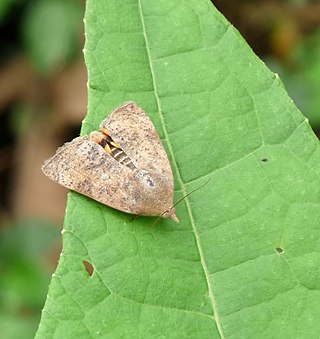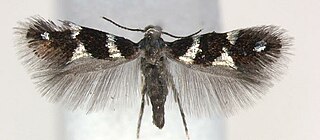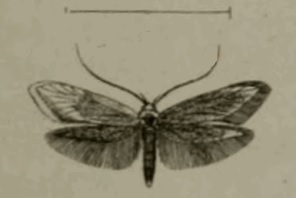
The Elachistidae are a family of small moths in the superfamily Gelechioidea. Some authors lump about 3,300 species in eight subfamilies here, but this arrangement almost certainly results in a massively paraphyletic and completely unnatural assemblage, united merely by symplesiomorphies retained from the first gelechioid moths.

Gelechioidea is the superfamily of moths that contains the case-bearers, twirler moths, and relatives, also simply called curved-horn moths or gelechioid moths. It is a large and poorly understood '"micromoth" superfamily, constituting one of the basal lineages of the Ditrysia.

Hyblaeidae are the "teak moths", a family of insects in the Lepidopteran order. The two genera with about 18 species make up one of the two families of the Hyblaeoidea superfamily, which in the past has been included in the Pyraloidea. Recent phylogenetic studies find varying relationships of Hyblaeoidea among Ditrysian Lepidoptera: Mutanen et al. (2010) find the superfamily to group either with Pyraloidea, or – more often – with Thyridoidea or butterflies. The results of Wahlberg et al. (2013) and Heikilä et al. (2015) indicate a sister-group relationship with Pyraloidea.

The Batrachedridae are a small family of tiny moths. These are small, slender moths which rest with their wings wrapped tightly around their bodies.

The Heliozelidae, commonly known as shield-bearer moths, are a family of small, day flying monotrysian moths distributed worldwide. The larvae of most heliozelid species are leaf miners who cut distinctive shield-shaped cases from the surface of the host leaf, hence the common name. Some species are considered pests of commercial crops such as grapevines, cranberries, and walnuts. The taxonomy of this family is poorly understood.

Pterolonchidae is a small family of very small moths in the superfamily Gelechioidea. There are species native to every continent except Australia and Antarctica.

The Obtectomera is a clade of macro-moths and butterflies, comprising over 100,000 species in at least 12 superfamilies.

Homaledra is a small genus of at least four species small moth of the family Pterolonchidae native to North and South America.

Depressariidae is a family of moths. It was formerly treated as a subfamily of Gelechiidae, but is now recognised as a separate family, comprising about 2,300 species worldwide.
Chedra microstigma is a tiny moth of the family Batrachedridae described in 1907. It has only been found on Oahu. It has been found feeding on sedges, plants belonging to the Cyperaceae family, and its larvae host at least three species of parasitoids in Hawaii.

Stephensia is a genus of the small and very small moths of the family Elachistidae.

Perittia is a genus of moths of the family Elachistidae.
Coelopoeta is a relatively divergent genus of small moths in the superfamily Gelechioidea, which have only been found in western North America.
Coelopoeta phaceliae is a moth in the superfamily Gelechioidea. It is found in the US state of California.
Coelopoeta maiadella is a moth in the superfamily Gelechioidea. It is found in Yukon, Canada.

Syringopais temperatella, the cereal leaf miner or wheat leaf miner, is a very small sized moth of the family Pterolonchidae. It is found on Cyprus and in Greece and the Near East. It is an important pest in cereal grain fields in some areas.

Homaledra heptathalama, the exclamation moth or palm leaf housemaker, is a moth in the family Pterolonchidae. It was described by August Busck in 1900. It is found in the United States, where it has been recorded from Alabama, Florida and South Carolina.
Homaledra sabalella, the palm leaf skeletonizer moth, is a moth in the family Pterolonchidae. It is found in North America, where it has been recorded from Alabama, Florida, Mississippi, South Carolina and Texas. It is also present in Puerto Rico, Hispaniola and Cuba.
Epimarptidae was a former, or is a possible, monotypic family of moths in the moth superfamily Gelechioidea. It can now be seen as either a synonym of family Batrachedridae, or a monotypic subfamily of that family.

Pterolonche is small genus of small moths of the family Pterolonchidae.











